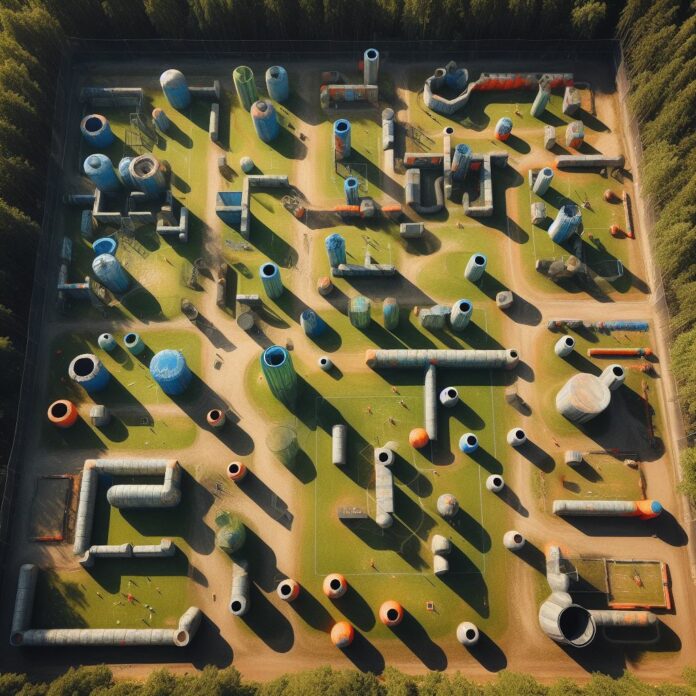Setting up a paintball field requires careful planning and attention to detail. Whether you’re a paintball enthusiast looking to create your own field or a business owner seeking to provide an exciting experience for players, understanding the necessary steps is essential.
Here’s a comprehensive guide on how to set up a paintball field:
1. Introduction to Setting Up a Paintball Field:
Setting up a paintball field involves various aspects, including choosing the right location, obtaining permits, designing the layout, gathering equipment, setting up safety measures, preparing the field for gameplay, and maintaining and upgrading the field over time.
2. Choosing the Right Location:
The success of your paintball field largely depends on selecting the right location. Consider factors such as the size and terrain, ensuring sufficient space for gameplay, and diverse landscapes. Accessibility and safety should also be prioritized in selecting a location that is easily reachable for players and provides a secure environment.
3. Obtaining Permits and Legal Requirements:
Before starting a paintball field, you must comply with any local permits and legal requirements. Check with local authorities to understand zoning regulations, any noise restrictions, and safety protocols that must be followed to ensure a safe and legal operation.
4. Designing the Layout:
The layout of your paintball field is crucial for creating an engaging and challenging experience for players. Consider incorporating various field structures and obstacles to provide cover and strategic positions. Plan the arrangement of bunkers and other structures strategically to create a dynamic and exciting gameplay environment.
5. Gathering and Maintaining Equipment:
To run a successful paintball field, you will need to invest in the necessary equipment. This includes paintball guns, protective gear for players, and an ample supply of paintballs and air systems. Regular maintenance of the equipment is essential to ensure their proper functioning and the safety of participants.
6. Setting Up Safety Measures:
Safety should be a top priority when setting up a paintball field. Conduct comprehensive safety briefings to educate players about the rules and regulations. Ensure that emergency services and first aid provisions are in place to handle any unforeseen situations.
7. Preparing the Field for Gameplay:
Before players can enjoy the field, it must be properly prepared. Clear and mark boundaries to define the playing area. Set up game zones with different themes or objectives to provide a varied and exciting experience for players.
8. Maintaining and Upgrading the Paintball Field:
Regular inspections and repairs are necessary to keep the field in excellent condition. Address any safety concerns or structural issues promptly. Periodically adding new features and challenges can help keep the field fresh and attract repeat players.
By following these steps, you can create a well-designed and safe paintball field that offers an enjoyable experience for players of all skill levels.
Choosing the Right Location
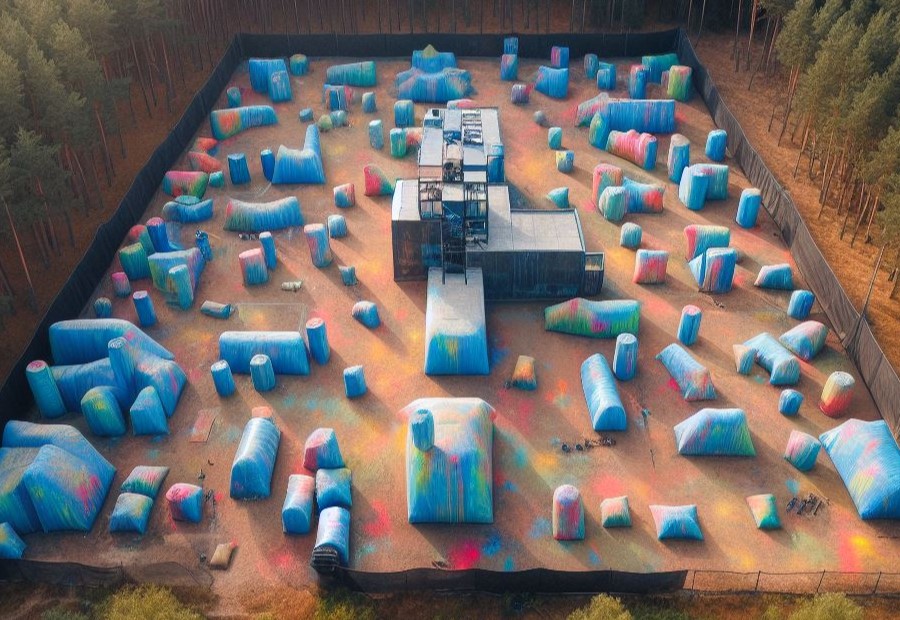
Looking to set up a paintball field? The first crucial step is choosing the right location. In this section, we’ll explore two important factors – size and terrain, as well as accessibility and safety.
Discover how the size and terrain of the field can impact the paintball experience, and why accessibility and safety measures are essential for players. Get ready to find the perfect spot to unleash your paintball skills and create an unforgettable battleground.
Size and Terrain
The size and terrain play important roles in setting up a paintball field. When creating a paintball field, it is crucial to consider the size and terrain. The provided table offers details about the size and terrain of the field:
| Size | Terrain |
| For optimal gameplay and tactical maneuvers, the field should be at least 1 to 1.5 acres in size. | To provide players with diverse gameplay experiences, the terrain should consist of a mixture of open areas, dense vegetation, and natural obstacles like rocks or trees. |
| For larger fields, such as tournament fields, it is recommended to have a minimum size of 2 to 3 acres to accommodate more players and different game scenarios. | Enhancing the tactical aspects of the field, man-made structures like bunkers and barriers can be incorporated to provide cover for players. |
By taking into account the size and terrain, you can create a paintball field that offers challenging gameplay and caters to the preferences of different players. It is essential to have enough space for strategic movements and thrilling encounters.
Incorporating a variety of terrain features will add excitement and diversity to the gameplay, ensuring an enjoyable and immersive experience for all participants.
Accessibility and Safety
When setting up a paintball field, it is crucial to prioritize accessibility and safety. To ensure a safe and accessible environment for players, there are several factors to consider.
- Clear pathways: Create clear pathways throughout the field to ensure easy and safe movement for players. These pathways should be free from obstacles and well-marked.
- Adequate lighting: Install proper lighting to enhance visibility and prevent accidents, especially if games will be played during evening hours.
- Barrier fencing: Use barrier fencing to clearly define the boundaries of the field and prevent unauthorized access. Make sure the fencing is sturdy and properly secured.
- First aid stations: Have designated first aid stations on-site, stocked with necessary medical supplies and equipment. Ensure that staff members are trained in first aid and can provide assistance if needed.
- Emergency evacuation plan: Develop a comprehensive emergency evacuation plan and communicate it to all staff and participants. This plan should include procedures for various emergency scenarios, such as severe weather or injuries.
- Safety briefings: Before each game, conduct safety briefings to educate players about the rules, safety protocols, and potential hazards. It is important to emphasize the importance of wearing protective gear at all times.
- Regular inspections: Conduct regular inspections of the field to identify any safety hazards or maintenance needs. This includes checking for loose obstacles, inspecting bunkers for stability, and ensuring that all equipment is in good working condition.
By prioritizing accessibility and safety, you can create a paintball field that provides a thrilling and secure experience for all participants.
Obtaining Permits and Legal Requirements
When it comes to setting up a paintball field, it is essential to obtain permits and fulfill all legal requirements. To ensure compliance, follow these steps:
- Thoroughly research the local regulations and zoning laws that apply to paintball fields in your area.
- Contact the appropriate local government office to inquire about the permits and licenses that are necessary.
- Submit all the necessary paperwork and applications to obtain the required permits.
- Schedule inspections by the relevant authorities to ensure that your field meets the necessary safety and operational standards.
- Make any adjustments or improvements as required by the authorities.
- Secure liability insurance coverage to protect yourself and your business in the event of accidents or injuries.
- Make sure to prominently display all permits, licenses, and safety certifications at your paintball field.
Adhering to these legal requirements is crucial for the smooth and safe operation of your paintball field. Failure to comply can result in penalties, fines, or even the closure of your business.
It is also beneficial to maintain open communication with the local government and foster positive relationships for the long-term success of your paintball field.
Designing the Layout
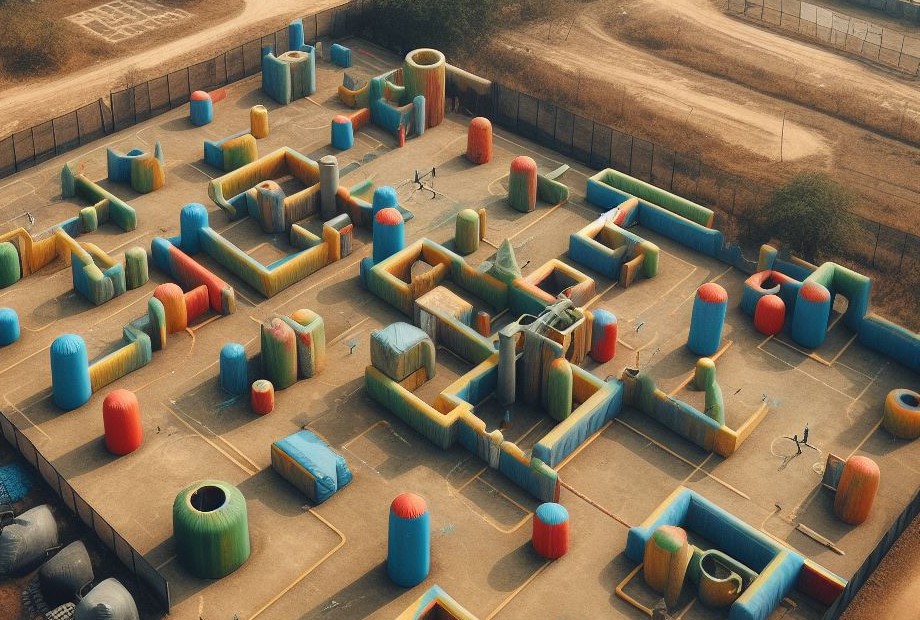
Designing the layout of a paintball field is an essential aspect of creating an exhilarating and challenging gameplay experience. In this section, we’ll dive into the specifics of field structures and obstacles, as well as the importance of strategic cover and bunkers.
Get ready to explore how these elements can make or break the excitement and intensity of a paintball game. So, grab your gear and join us as we unveil the secrets to crafting an unforgettable paintball field.
Field Structures and Obstacles
When setting up a paintball field, it is important to strategically design field structures and obstacles to enhance gameplay and create a challenging environment for players. Here are some key factors to consider:
- Placement: Carefully position field structures and obstacles throughout the playing area to create a balanced and engaging experience for players.
- Variety: Incorporate a variety of field structures and obstacles, such as wooden structures, barrels, tires, and walls, to provide different levels of cover and strategic options for players.
- Size and Shape: Choose field structures and obstacles that vary in size and shape to allow for diverse gameplay scenarios. This can include large structures for team objectives and smaller ones for individual cover.
- Line of Sight: Consider how field structures and obstacles affect visibility on the field. Strategically place them to create open areas for long-range shots and areas for close-quarters combat.
- Safety: Ensure that the field structures and obstacles are safe for players to interact with. Regularly inspect and maintain them to prevent any hazards or potential injuries.
- Theme: Depending on the theme or scenario of your paintball field, you can design field structures and obstacles that align with the overall concept. This can add an extra layer of excitement and immersion for players.
By following these guidelines, you can create a paintball field with well-designed field structures and obstacles that contribute to an exhilarating and challenging gameplay experience.
Cover and Bunkers
When setting up a paintball field, cover and bunkers are of utmost importance as they provide strategic hiding spots and obstacles for players. Here are some key points to consider:
- Type of Cover: Choose a variety of cover options, such as barrels, tires, and wooden structures, to offer diverse hiding places for players.
- Placement: Strategically position the cover and bunkers throughout the field to create challenging game scenarios. Consider the visibility and accessibility of each bunker.
- Size and Shape: Incorporate a mix of different sizes and shapes for bunkers to accommodate different play styles and provide varying degrees of protection.
- Durability: Ensure that the cover and bunkers are sturdy enough to withstand the impact of paintball shots. Regularly inspect and maintain them to keep them in good condition.
- Visibility: Take into account the visibility of the cover from different angles on the field. This will add strategic elements to the gameplay and force players to adapt their tactics.
- Spacing: Carefully plan the spacing between bunkers to allow enough room for players to move and maneuver, while also creating opportunities for ambushes and tactical plays.
- Integration with Game Zones: Seamlessly integrate the cover and bunkers into the overall game zones on the field. They should complement the layout and enhance the gameplay experience.
By carefully considering the cover and bunkers in your paintball field, you can create an exciting and challenging environment for players, enhancing the overall experience.
Remember to regularly assess and adjust the layout based on player feedback and evolving strategies.
Gathering and Maintaining Equipment
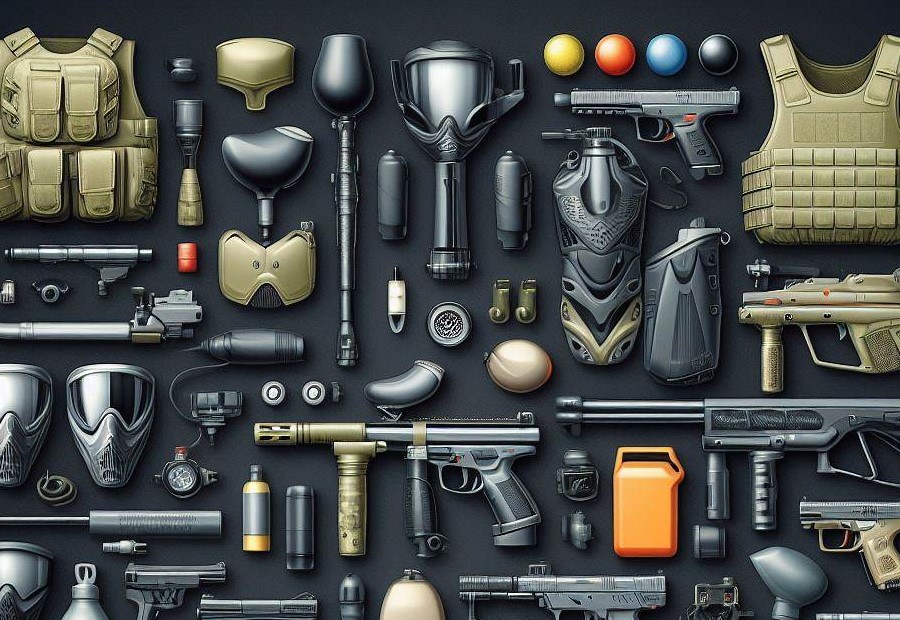
When it comes to setting up a paintball field, one of the most crucial aspects is gathering and maintaining the necessary equipment.
This includes everything from paintball guns to protective gear, as well as the critical components like paintballs and air systems.
In this section, we’ll dive into each of these elements, exploring their importance and how they contribute to the excitement and safety of paintball enthusiasts.
So, gear up and get ready to discover the key ingredients needed for a thrilling paintball experience.
Paintball Guns
- Quality: When choosing paintball guns, it is crucial to consider their quality. Look for markers that are made from durable materials and have a reputation for reliability.
- Firing Modes: Different paintball guns offer various firing modes. Some guns have a semi-automatic firing mode, while others have modes such as burst or fully automatic. Consider the type of gameplay you will be participating in and select a gun with the appropriate firing mode.
- Accuracy: The accuracy of paintball guns is another vital factor to consider. Look for guns that have a reputation for shooting straight and consistently hitting targets.
- Weight and Size: The weight and size of paintball guns can significantly impact your gameplay experience. Choose a gun that feels comfortable and easy to maneuver for you.
Protective Gear
When it comes to setting up a paintball field, ensuring the players have proper protective gear is crucial to their safety. Here are some essential items to consider:
- Paintball masks: These are the most critical pieces of protective gear. They provide full face and eye protection, preventing injuries from paintballs.
- Chest protectors: These padded vests offer additional protection for the chest and back from the impact of paintballs.
- Padded gloves: Gloves protect the hands from direct hits and provide better grip on the paintball gun.
- Knee and elbow pads: These pads protect vital joints, reducing the risk of bruises and scrapes while crawling or sliding on the field.
- Neck protectors: These coverings keep the neck safe from fast-flying paintballs.
Remember, it is essential to choose high-quality protective gear that meets safety standards. Inspect the gear regularly for any signs of wear or damage and replace it if necessary.
Ensuring all players have correctly fitting gear is also vital for maximum protection. Safety should always be the top priority when setting up a paintball field.
Paintballs and Air Systems
| Paintballs | Air Systems |
| Paintballs are essential ammunition in paintball guns. They consist of petite spherical capsules filled with water-soluble dye. | Air systems are utilized to power the paintball guns. They provide the necessary compressed air or carbon dioxide to propel the paintballs. |
| The paintballs are available in various sizes, typically ranging from 0.68 to 0.50 caliber. It is crucial to match the size of the paintball with the bore size of the paintball gun for accuracy and optimal functioning. | Air systems can be either CO2 (carbon dioxide) or HPA (high-pressure air). CO2 tanks are more budget-friendly but can be affected by temperature changes. On the other hand, HPA tanks are more consistent and reliable, albeit at a higher cost. |
| There is a wide range of paintball types available, including tournament-grade, practice-grade, and recreational-grade. Tournament-grade paintballs are designed for professional play, with a thick shell. Practice-grade paintballs, with a thinner shell, are more affordable and suitable for training sessions. Recreational-grade paintballs are the most economical option, catering to casual play. | Regular inspection and maintenance of air systems are imperative to ensure safe and reliable operation. Tanks should undergo hydro-testing every few years to guarantee their ability to withstand high pressure. |
Paintballs and air systems play a critical role in the paintball game. The size and type of paintballs used have a direct impact on accuracy and performance.
Similarly, the choice between CO2 and HPA air systems dictates the reliability and consistency of the paintball gun.
Therefore, it is essential to properly maintain and care for air systems to ensure safe and reliable gameplay.
Setting Up Safety Measures
When it comes to setting up a paintball field, one crucial aspect that cannot be overlooked is safety. In this section, we will dive into the essential safety measures that need to be in place.
We’ll explore the importance of safety briefings and rules, ensuring that players are well-prepared and informed before stepping onto the field.
Additionally, we’ll discuss the significance of having emergency services and first aid readily available, guaranteeing a swift and effective response in case of any unforeseen incidents.
Safety is paramount, and in this section, we’ll show you how to prioritize it when setting up a paintball field.
Safety Briefings and Rules
When it comes to ensuring a safe and enjoyable experience at a paintball field, safety briefings and rules are absolutely crucial.
- It is essential to provide comprehensive safety briefings to all players before the game play begins. This includes explaining the rules, emphasizing the importance of protective gear, and demonstrating proper handling of paintball guns.
- One must clearly outline the boundaries of the playing area and any off-limit zones to prevent players from venturing into dangerous areas.
- Strict safety protocols need to be enforced, such as maintaining a minimum shooting distance to prevent injuries. This ensures that players maintain a safe distance from each other during gameplay.
- Rules regarding shooting at opponents should be implemented. For instance, adopting a “no headshots” policy or requiring players to aim below the waist can help mitigate potential injuries.
- It is important to emphasize the significance of communication among players during gameplay. Encouraging players to shout “surrender” when they have a clear advantage over an opponent can avoid unnecessary confrontations.
- Regular inspections and maintenance of the field structures and obstacles should be conducted to ensure they are safe and in good condition. This includes checking for loose or unstable objects that could cause accidents.
- Trained staff members or referees should monitor the gameplay to ensure that all players adhere to the safety rules. They can provide assistance and intervene if necessary.
- An emergency action plan should be prepared in case of injuries or other emergencies. This includes having first aid kits readily available and establishing procedures for contacting emergency services.
By implementing thorough safety briefings and rules, paintball field operators can create a safe environment for players to enjoy this exciting sport.
Emergency Services and First Aid
The provision of emergency services and first aid is of utmost importance when setting up a paintball field. Ensuring the safety of players involves considering the following key points:
- Emergency services: It is critical to have a well-defined plan in place for accessing emergency medical services in the event of injuries during gameplay. This may require having contact information for local medical facilities readily available and establishing communication protocols with emergency services personnel.
- First aid kits: Every paintball field should have easily accessible, fully stocked first aid kits for treating minor injuries. These kits should include essential items such as bandages, antiseptic solutions, adhesive tape, and disposable gloves. Regular inspection and restocking of these kits are vital to ensure their availability during emergencies.
- Trained personnel: It is advisable to have on-site staff members or volunteers who are trained in first aid and CPR (cardiopulmonary resuscitation). These individuals can provide immediate assistance in case of injuries and stabilize players until professional medical help arrives.
- Emergency protocols: Establishing clear procedures for handling emergencies is imperative. This involves assigning specific individuals responsible for calling emergency services, managing the scene of an injury, and ensuring players are directed to a safe area during emergencies.
By prioritizing the provision of emergency services and first aid, paintball field operators can greatly enhance the safety and well-being of players. This creates an environment where participants can fully enjoy the game while having peace of mind.
Preparing the Field for Gameplay
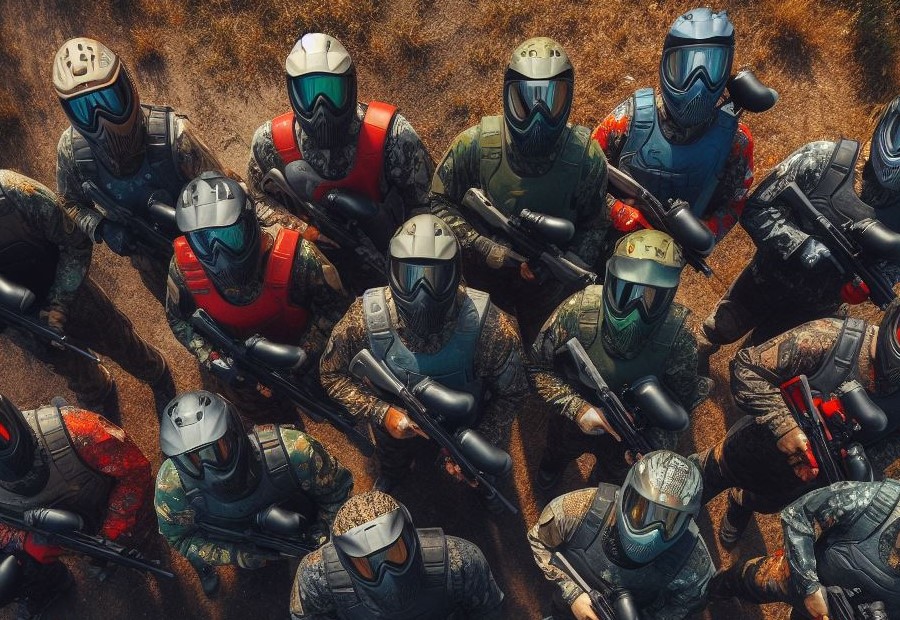
Preparing the field for an exhilarating paintball gameplay involves essential steps that ensure safety and an immersive experience. From clearing and marking boundaries to setting up game zones, each sub-section plays a crucial role in creating the perfect battleground.
Discover how meticulous planning and careful execution lay the foundation for an adrenaline-fueled adventure, where players can push their limits, strategize, and unleash their competitive spirit in the world of paintball. Let the battle begin!
Preparing the field for an exhilarating paintball gameplay involves essential steps that ensure safety and an immersive experience. From clearing and marking boundaries to setting up game zones, each sub-section plays a crucial role in creating the perfect battleground.
Discover how meticulous planning and careful execution lay the foundation for an adrenaline-fueled adventure, where players can push their limits, strategize, and unleash their competitive spirit in the world of paintball. Let the battle begin!
Clearing and Marking Boundaries
Clearing and marking boundaries is an essential step in setting up a paintball field. It helps ensure the safety and fairness of gameplay. Here is a list of steps to follow:
- Inspect the area to determine its boundaries.
- Remove any debris, such as rocks or fallen branches, that may obstruct the playing area.
- Mark the boundaries using brightly colored tape or paint.
- Install boundary signs or flags at key points to clearly indicate the limits of the field.
- Regularly monitor and maintain the boundaries to ensure they remain visible and intact.
Setting Up Game Zones
When setting up game zones for a paintball field, there are several important factors to consider:
- Zone layout: Design the layout of the game zones to provide variety and challenge for players. Create different types of terrain, such as forests, open fields, and buildings, to add excitement to gameplay.
- Bunkers and obstacles: Position bunkers strategically throughout the game zones to provide cover for players and create tactical advantages. Use a variety of obstacles, such as barrels, walls, and tires, to enhance the gameplay experience.
- Game objectives: Decide on different game objectives for each game zone to keep gameplay interesting. These objectives can include capturing a flag, defending a base, or eliminating opponents. Incorporate a mix of both individual and team-based objectives.
- Boundaries: Clearly mark the boundaries of each game zone to ensure that players know the limits of the playing area. Use boundary tape, flags, or other markers to indicate the edges of the zone.
- Safety considerations: Prioritize the safety of players when setting up game zones. Ensure that there are no hazardous obstacles or terrain features that could cause injury. Regularly inspect the game zones for any potential dangers.
Paintball originated in the 1980s as a recreational activity but quickly evolved into a competitive sport. The first organized paintball game took place in 1981 in New Hampshire, USA. The game was initially played using simple paintball markers, which were adapted from agricultural marking guns.
Over the years, the sport grew in popularity and led to the development of specialized equipment and dedicated paintball fields. Setting up game zones became an integral part of creating engaging and challenging paintball experiences for players of all skill levels.
Maintaining and Upgrading the Paintball Field
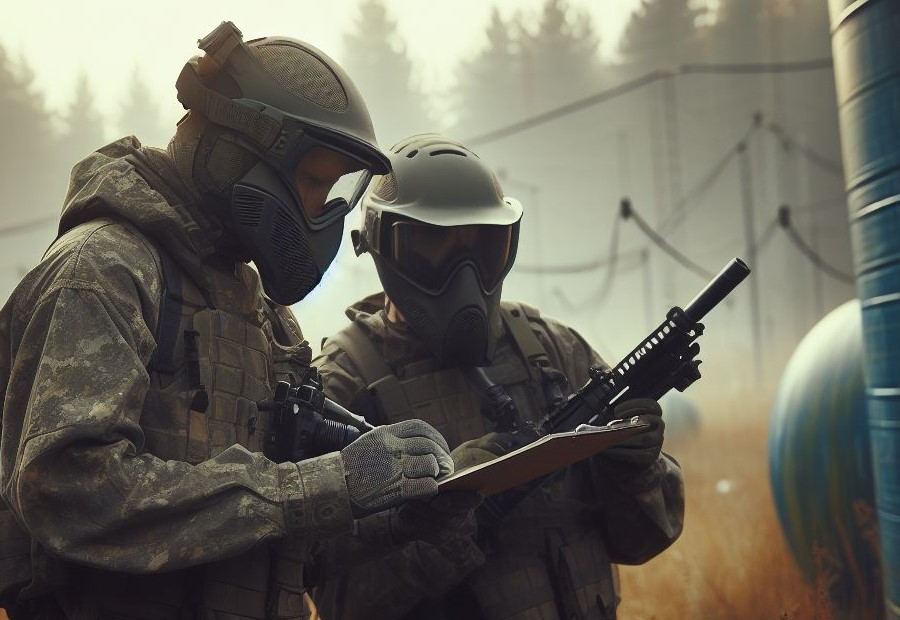
Maintaining and upgrading your paintball field is essential for delivering an exhilarating gaming experience. In this section, we’ll dive into the key elements of keeping your field in top shape.
From conducting regular inspections and repairs to adding new features and challenges, we’ll explore how these efforts contribute to the smooth operation and ongoing excitement of your paintball field.
So grab your gear, because we’re about to take your paintball field to the next level!
Regular Inspections and Repairs
Regular inspections and repairs are crucial for maintaining the quality and safety of a paintball field. Here are some key points to consider:
- Inspection schedule: Establish a regular schedule for inspections to ensure that all aspects of the field are thoroughly checked. This can be done monthly, quarterly, or depending on the level of usage.
- Check field structures: Regular inspections and repairs are important for maintaining the quality and safety of a paintball field. Inspect all field structures, such as bunkers and barriers, for any damage or wear and tear. Repair or replace any damaged structures to maintain player safety.
- Inspect playing surfaces: Regular inspections and repairs are crucial for maintaining the quality and safety of a paintball field. Examine the playing surfaces for any cracks, holes, or uneven terrain that may pose a risk to players. Repair and level the surfaces as needed to prevent accidents.
- Review safety equipment: Regular inspections and repairs are essential for maintaining the quality and safety of a paintball field. Inspect all safety equipment, including protective gear and barriers, to ensure they are in good working condition. Replace worn-out or damaged equipment to provide optimal protection to players.
- Maintenance of paintball guns: Regular inspections and repairs are necessary for maintaining the quality and safety of a paintball field. Regularly inspect and clean paintball guns to ensure they are functioning properly. Address any issues promptly to avoid equipment malfunction during gameplay.
- Monitor paintball supply: Regular inspections and repairs are vital for maintaining the quality and safety of a paintball field. Keep track of the paintball supply and ensure that there are enough paintballs for gameplay. Regularly check for expired or damaged paintballs and replace them accordingly.
- Address player feedback: Regular inspections and repairs are key for maintaining the quality and safety of a paintball field. Take player feedback into consideration during inspections. Address any concerns or suggestions raised by players to improve the overall experience and safety of the field.
By conducting regular inspections and repairs, you can ensure that your paintball field remains in top condition and provides a safe and enjoyable experience for players.
Adding New Features and Challenges
When it comes to setting up a paintball field, adding new features and challenges is an essential aspect. Here are some ideas to consider:
1. Obstacle Course: Set up various obstacles like walls, tires, and barrels to create a challenging course for players to navigate through.
2. Sniper Towers: Construct elevated platforms that provide a strategic advantage for players who prefer a long-range playstyle.
3. Forts and Bunkers: Build sturdy structures that can serve as defensive positions or control points during gameplay.
4. Capture the Flag Zone: Designate a specific area on the field where teams can compete to capture and defend each other’s flags, adding an extra layer of strategy and teamwork.
5. Dynamic Cover: Incorporate movable objects like crates and barrels that players can strategically position to enhance their cover during battles.
Frequently Asked Questions
How do I start a paintball field as a business?
Owning a paintball field requires careful planning and treating it as a business. Consider factors such as location, permits, insurance, and equipment costs. Create a detailed business plan and seek advice from experienced field owners.
Approach the venture as a business and consider all necessary factors before diving in.
How can I make my paintball business more profitable?
There are several strategies to make your paintball business more profitable. Some options include offering experienced customers play in exchange for employee services, purchasing CO2 tanks instead of renting them, renting out equipment, selling merchandise, and sponsoring teams.
By diversifying your income stream opportunities and being creative, you can increase your profitability.
What permits and licenses do I need to operate a paintball field?
To operate a paintball field, you will need to obtain necessary permits and licenses. This may include a business license from your local government, a sales tax license from your state Department of Revenue, as well as liability waivers, protective gear, safety regulations, and a Certificate of Occupancy.
It is important to consult with local authorities to ensure compliance with all regulations and requirements.
What are the key considerations when designing a paintball course?
When designing a paintball course, key considerations include the type of game you want to play, such as capture the flag or team deathmatch, and creating a maze of obstacles for players to navigate.
You can use materials like rocks, cardboard, sand-filled bags, or trenches to create hiding places and barricades. Testing the safety of the course is also crucial to avoid accidents.
How can I attract customers to my paintball field?
To attract customers to your paintball field, define your brand and promote your business through market research, brochures, partnerships with local organizations and businesses, and a professionally created website.
Offering merchandise, loyalty rewards programs, and hosting special events or tournaments can also help attract and retain customers. Additionally, consider reaching out to local sports teams, fitness clubs, civic groups, and corporations to organize paintball team competitions.

